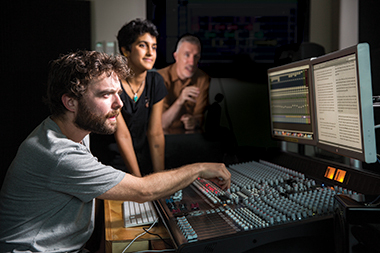Back to the future

Students Thomas Capogreco and Iran Sanadzadeh with the
Head of Sonic Arts, Stephen Whittington It’s 1962 and the University of Adelaide has appointed its first visiting composer in electronic music at the Elder Conservatorium of Music.
In order to perform his music to an audience, composer Henk Badings from The Netherlands uses only magnetic tape recordings (technology that was invented in Germany prior to World War II) and a self-constructed “patch panel”, which enables him to create and modulate electronic sounds.
To study this new form of music – a radical departure for one of Australia’s oldest and most distinguished music schools – students and staff must build their own versions of what we now describe as “synthesizers” and basic “computers” from scratch; these items do not currently exist on store shelves.
Combining the expertise of an electronics technician with the guiding light of art, Dr Badings and those who follow – such as the celebrated composer Tristram Cary – are placing the University of Adelaide at the forefront of electronic music in Australia.
Half a century later, and the department store shelves contain numerous keyboards, synthesizers and computers of all kinds – including mobile phones and tablets that have four million times the memory of the Apple II, the first computer ever owned by the University’s electronic music program.
But in a nod to those pioneering times of the 1960s and ’70s, today’s students undertaking the University’s Sonic Arts program, as it’s now known, are again building their own equipment from scratch, as well as writing their own software.
The Head of Sonic Arts, Stephen Whittington, explains: “The hands-on approach that used to be taken here many years ago is still an important part of the course now. That’s in keeping with the spirit of the early days but really it’s to get the students to appreciate what’s involved.
“We’ve got ‘circuit-bending and hardware hacking’, for example, which is very popular with students; they love it. By getting to know the inside workings of devices, and how they can be manipulated, the students are discovering creative aspects to the work that they never expected.”
That’s not to say the Sonic Arts program doesn’t keep up with technology, quite the contrary. New software, hardware and a range of digital technologies are constantly being assimilated into the program so that students and staff alike remain up-to-date.
But that can’t replace the students’ individual creativity – such as the student who built her own “laser harp”, which uses beams of light instead of conventional strings.
“Our approach changes the student from being a passive user to an active participant,” says Lecturer and Electronic Music Unit Director Christian Haines. “Many students find they enjoy the self-creation process so much, such as writing their own software, that they don’t even want to use the pre-purchased software; and that’s a great discovery to make. They’re engaged and shaping the area in which they work.”
Although part of the Elder Conservatorium of Music, the term “Sonic Arts” is designed to cover more than just music. “We call it Sonic Arts now because ‘electronic music’ was too narrow,” Mr Whittington says. “Broadly, Sonic Arts is anything to do with making sound and music primarily using digital means, but not exclusively.”
“We’ve broadened our scope too, into making visual art, game sound, film sound and interactive media,” says Sonic Arts lecturer Dr Luke Harrald. “Given the rise of mobile devices, that’s one of the big directions; there’s a lot of content needed for mobile platforms.”
Sonic Arts has been steadily increasing in undergraduate student numbers over recent years, a promising sign of the current interest. At postgraduate level there are students studying areas such as computer game sound, how to use games themselves as an instrument, the use of artificial intelligence in musical performance, and mixing live ambient sounds with music in real time.
But while many students initially develop their interests in this field by tinkering with sound and composition in their own bedrooms, the Sonic Arts program also has its own orchestra, bringing live performance and group collaboration quite literally into the mix. Earlier this year, the Electronic Noise Orchestra (ENO) saw 65 students operating laptops and mixing desks, performing works by Brian Eno on stage in a free concert at the Scott Theatre. It’s believed to be the biggest student electronic orchestra performance of its kind in the world.
“It was unprecedented – nothing had ever been done on that scale before,” Mr Whittington says. “And while the musical outcome is less important than learning from the collaborative side of it, I’m pleased to say it held up as a performance in its own right.”
Dr Henk Badings would have been proud.
|





